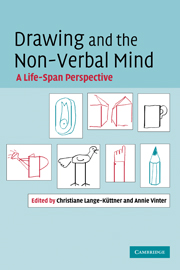Book contents
- Frontmatter
- Contents
- Contributors
- 1 Contemporary enquiries into a long-standing domain: Drawing research
- Part I Self, symbols and intention
- Part 2 Syntax, space systems and projection
- Part III Aging, blindness and autism
- 13 Benefits of graphic design expertise in old age: compensatory effects of a graphical lexicon?
- 14 Drawing as a ‘window’ on deteriorating conceptual knowledge in neurodegenerative disease
- 15 Drawings by a blind adult: orthogonals, parallels and convergence in two directions without T-junctions
- 16 Differences between individuals with and without autism in copying tasks: how knowledge interferes when drawing perspective
- Index
- References
15 - Drawings by a blind adult: orthogonals, parallels and convergence in two directions without T-junctions
Published online by Cambridge University Press: 22 September 2009
- Frontmatter
- Contents
- Contributors
- 1 Contemporary enquiries into a long-standing domain: Drawing research
- Part I Self, symbols and intention
- Part 2 Syntax, space systems and projection
- Part III Aging, blindness and autism
- 13 Benefits of graphic design expertise in old age: compensatory effects of a graphical lexicon?
- 14 Drawing as a ‘window’ on deteriorating conceptual knowledge in neurodegenerative disease
- 15 Drawings by a blind adult: orthogonals, parallels and convergence in two directions without T-junctions
- 16 Differences between individuals with and without autism in copying tasks: how knowledge interferes when drawing perspective
- Index
- References
Summary
Kennedy and Juricevic argue that in both normal sighted and blind people the development of drawing using spatial projection systems proceeds from an orthogonal basis to freehand versions of parallel perspective and inverse perspective, and then to viewpoint perspective in which convergence shows parallel edges in the scene. They suggest the development of visually realistic contour drawing using T-junctions for overlap occurs independently. The authors report a case study of a blind young woman, Tracy T, who has had exceptionally extensive drawing practice since childhood. In the case study, Tracy T used a raised line drawing kit to draw objects in various orientations. A verbal protocol was taken while drawing. Tracy T drew a 3D cube in perspective, objects from various directions and figures involved in actions. Most strikingly, she used two-point perspective when sketching the roof of a house from above. Sometimes her verbal comments would outstrip her graphic abilities. Notably, for Tracy T, overlap was a problem, and she left drawings requiring overlap incomplete. Improvisation helped her avoid problems in relatively free drawing tasks compared to more prescriptive ones. The study offers evidence that blind people tackle spatial drawing problems in similar ways to sighted people.
tracy t, a blind adult, has appreciable spatial skills and an interest in drawing. Here we find that her drawings generally employ orthogonals, that is, plans and elevations with correct orientation from the observer's vantage point. Occasionally they use freehand parallel, and one- and two-point projection.
- Type
- Chapter
- Information
- Drawing and the Non-Verbal MindA Life-Span Perspective, pp. 305 - 324Publisher: Cambridge University PressPrint publication year: 2008
References
- 1
- Cited by



